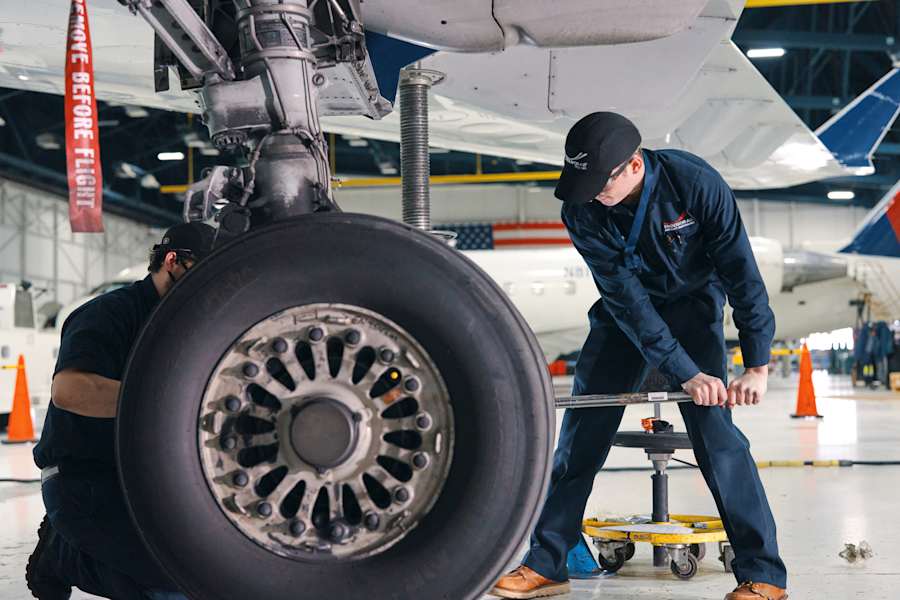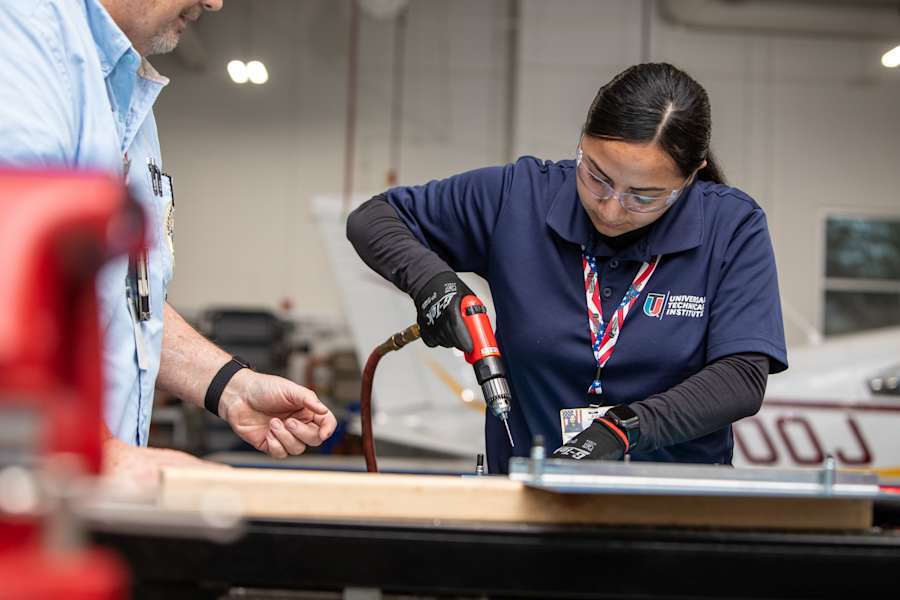Industrial Maintenance: A Definitive Guide
Industrial maintenance is a plan of action that businesses take to keep their equipment functioning for as long as possible. Learn more about what's involved here!
The aviation industry keeps planes running, driving economic growth, enabling international trade, transporting important cargo and connecting people across the globe.
Our reliance on plane travel and transportation has created a demand for airframe and powerplant (A&P)mechanics – especially ones that are licensed.
But how can getting an A&P license improve your career opportunities?
Keep reading to learn more about what airframe and powerplant mechanics do and the training required to enter the field!
Read: Is Becoming an Airframe and Powerplant Mechanic a Good Career Plan?
Airframe and powerplant refer to an aircraft’s two main physical components. The term airframe specifies the body of the aircraft, while the term powerplant specifies the engine. Most A&P mechanics service both, in addition to their related components, but others specialize in one of the two.
Airframe and powerplant mechanics perform their duties in compliance with the FAA. Doing so helps them ensure the fleets they attend to remain safe for flying.

An A&P license, or airframe and powerplant license, is a certification issued by the FAA that authorizes individuals to inspect, maintain and repair aircraft. The FAA is a United States government agency responsible for regulating and overseeing civil aviation, ensuring safety in air travel and airspace management.
This license is mainly categorized by the two main aviation components, airframe and powerplant. To obtain an A&P license, candidates must have a combination of formal training and hands-on experience, followed by passing written, oral and practical exams. This certification ensures mechanics in this field possess the necessary skills and knowledge to uphold safety regulations and standards in aviation maintenance.
Read: How To Become an A&P Mechanic
An A&P mechanic is a certified professional responsible for inspecting, maintaining and repairing aircraft systems to ensure they operate safely and efficiently. These specialists have extensive training in both airframe structures and engine components, allowing them to diagnose and resolve technical issues related to various types of aircraft.
Airframe and powerplant mechanics perform routine maintenance to ensure aircraft take off, fly and land safely. As previously mentioned, most A&P mechanics are generalists, meaning they’re familiar with the entirety of an aircraft, from the nose to the tail.
In addition to performing regular maintenance, A&P mechanics also test, diagnose and repair various components and systems within an aircraft. Common A&P mechanic duties include:
A&P mechanics often complete their tasks in a hangar, repair station or on an airfield, so it can be an exciting career for anyone who enjoys working with their hands while on their feet.
Wondering how to become an A&P mechanic? According to the Bureau of Labor Statistics (BLS), most mechanics attend an FAA-approved airframe and powerplant training program before pursuing a career in the industry.
As technology advances, so does the aviation field. Attending an FAA-approved program, like the curriculum provided by Universal Technical Institute (UTI), can give students practice using industry-aligned technology. It can also help prepare them to test for an FAA airframe and powerplant license.79 However, there are a few prerequisites to becoming FAA-licensed.

Read: A Recruiter’s Preferred Choice: Why CommuteAir Hires Our Grads
According to the FAA, candidates interested in taking the certification exam must meet the following requirements:
To pass the licensing test, candidates must be familiar with Title 14 of the Code of Federal Regulations and pass the written, oral and practical portions of the test.
There are three written tests offered:
All candidates must take the general knowledge written test. However, they may choose to take either the airframe test, powerplant test or both.
An airframe license certifies mechanics to work on the aircraft body while a powerplant license certifies them to work on the engine. The BLS reports that employers may prefer candidates with both airframe and powerplant certifications, meaning they can service the entire aircraft.
Read: What Other Schools May Not Teach You About FAA A&P Testing: Instructor David Lindsey Shares Insights
As previously mentioned, attending an FAA-approved airframe and powerplant training program can prepare graduates to test for FAA licensing and pursue a career in aviation.
UTI campuses offer training for the industry with an Airframe & Powerplant Technician program ranging from 18-20 months, depending on location.79

The curriculum has been developed with the help of industry leaders, so students can rest assured they're receiving industry-aligned instruction and hands-on training relevant to their chosen career path. Students are taught to service several different aircraft through airframe and powerplant courses, which cover topics like:
Most of our grads start out working as entry-level technicians or in other entry-level roles. As with any industry, over time, they may be able to advance in their career with experience and hard work. Keep reading to learn more about a career as an airframe and powerplant mechanic.
Read: “I’m Building a Career I’m Passionate About” – Jason Martinez’s Story
Most graduates of FAA-approved programs are prepared to pursue aviation mechanic careers as entry-level aircraft mechanics. Entry-level mechanics conduct scheduled maintenance, perform inspections per the FAA, diagnose electrical and mechanical issues, and repair and replace various aircraft components. Aircraft mechanics can work for airlines, commercial airfields that specialize in package delivery, or the military.
According to the BLS, there’s a demand for mechanics across the nation. Total aviation technician employment in the United States is expected to exceed 148,000 by 2033.71
A&P mechanics possess valuable skills that are in demand across the nation. It can be an exciting career for creative problem-solvers who enjoy overcoming exciting challenges, are detail-oriented and are mechanically inclined.
Yes, but only under the supervision of a certified A&P mechanic. Once the work is complete, the supervisor will have to approve it.
To obtain an A&P license, candidates must have the necessary combination of formal training and practical experience, which can include attending an FAA-approved aviation technician school. After this, they must successfully pass the written, oral and practical exams as required by the FAA, demonstrating their knowledge and skills in both airframe and powerplant systems.
An A&P mechanic can legally conduct inspections, maintenance and repairs on both the airframe and powerplant components of an aircraft. This includes working on the structure of the aircraft as well as the engines and associated systems, ensuring that all work meets FAA safety standards.
The job prospects for individuals with an A&P license are promising, with a growing demand for mechanics in various sectors of aviation. According to the BLS, total aviation technician employment is projected to increase, making it a potentially lucrative career choice for those with the appropriate credentials and skills.6
Read: The Three Most Important Parts of A&P Training at UTI, According to Abraham Garcia
The airframe and powerplant program offered at UTI is designed to prepare graduates to apply and test for FAA certification and pursue entry-level aviation roles.79,128 Throughout their training, students gain hands-on practice facilitated by instructors who have experience in the field.
In less than two years, they can gain the entry-level skills that many employers are seeking in a candidate, including knowledge of current technology and FAA standards.
Ready to get started? Request more information online or call us at 1-800-834-7308, and we’ll connect you to an Admissions Representative!
The Airframe & Powerplant Technician program is offered at numerous campus locations, including Avondale, AZ; Long Beach, CA; Miramar, FL; Canton, MI; and Houston, TX, campus locations.
Universal Technical Institute of Illinois, Inc. is approved by the Division of Private Business and Vocational Schools of the Illinois Board of Higher Education.